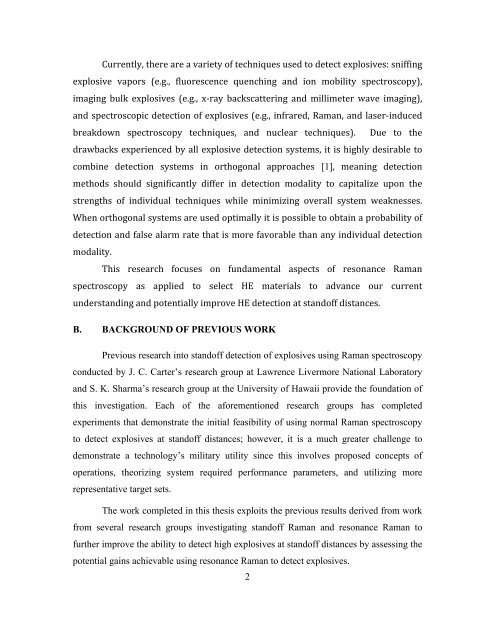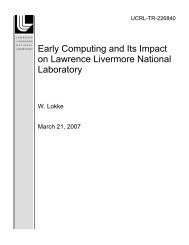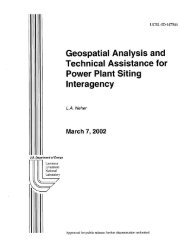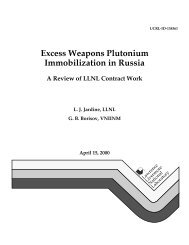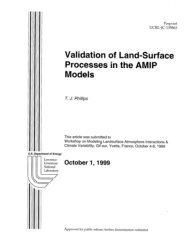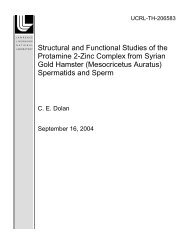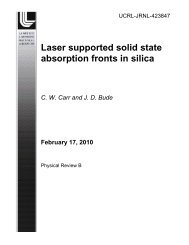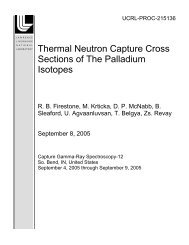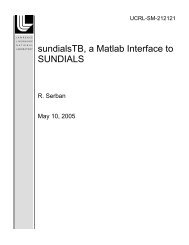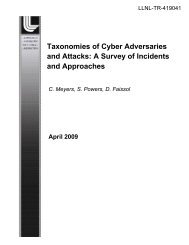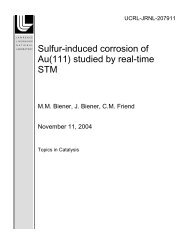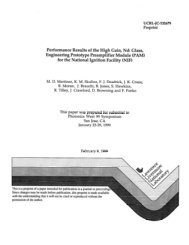Ultraviolet Resonant Raman Enhancements in the Detection of ...
Ultraviolet Resonant Raman Enhancements in the Detection of ...
Ultraviolet Resonant Raman Enhancements in the Detection of ...
You also want an ePaper? Increase the reach of your titles
YUMPU automatically turns print PDFs into web optimized ePapers that Google loves.
Currently, <strong>the</strong>re are a variety <strong>of</strong> techniques used to detect explosives: sniff<strong>in</strong>g <br />
explosive vapors (e.g., fluorescence quench<strong>in</strong>g and ion mobility spectroscopy), <br />
imag<strong>in</strong>g bulk explosives (e.g., x‐ray backscatter<strong>in</strong>g and millimeter wave imag<strong>in</strong>g), <br />
and spectroscopic detection <strong>of</strong> explosives (e.g., <strong>in</strong>frared, <strong>Raman</strong>, and laser‐<strong>in</strong>duced <br />
breakdown spectroscopy techniques, and nuclear techniques). Due to <strong>the</strong> <br />
drawbacks experienced by all explosive detection systems, it is highly desirable to <br />
comb<strong>in</strong>e detection systems <strong>in</strong> orthogonal approaches [1], mean<strong>in</strong>g detection <br />
methods should significantly differ <strong>in</strong> detection modality to capitalize upon <strong>the</strong> <br />
strengths <strong>of</strong> <strong>in</strong>dividual techniques while m<strong>in</strong>imiz<strong>in</strong>g overall system weaknesses. <br />
When orthogonal systems are used optimally it is possible to obta<strong>in</strong> a probability <strong>of</strong> <br />
detection and false alarm rate that is more favorable than any <strong>in</strong>dividual detection <br />
modality. <br />
This research focuses on fundamental aspects <strong>of</strong> resonance <strong>Raman</strong> <br />
spectroscopy as applied to select HE materials to advance our current <br />
understand<strong>in</strong>g and potentially improve HE detection at stand<strong>of</strong>f distances. <br />
B. BACKGROUND OF PREVIOUS WORK<br />
Previous research <strong>in</strong>to stand<strong>of</strong>f detection <strong>of</strong> explosives us<strong>in</strong>g <strong>Raman</strong> spectroscopy<br />
conducted by J. C. Carter’s research group at Lawrence Livermore National Laboratory<br />
and S. K. Sharma’s research group at <strong>the</strong> University <strong>of</strong> Hawaii provide <strong>the</strong> foundation <strong>of</strong><br />
this <strong>in</strong>vestigation. Each <strong>of</strong> <strong>the</strong> aforementioned research groups has completed<br />
experiments that demonstrate <strong>the</strong> <strong>in</strong>itial feasibility <strong>of</strong> us<strong>in</strong>g normal <strong>Raman</strong> spectroscopy<br />
to detect explosives at stand<strong>of</strong>f distances; however, it is a much greater challenge to<br />
demonstrate a technology’s military utility s<strong>in</strong>ce this <strong>in</strong>volves proposed concepts <strong>of</strong><br />
operations, <strong>the</strong>oriz<strong>in</strong>g system required performance parameters, and utiliz<strong>in</strong>g more<br />
representative target sets.<br />
The work completed <strong>in</strong> this <strong>the</strong>sis exploits <strong>the</strong> previous results derived from work<br />
from several research groups <strong>in</strong>vestigat<strong>in</strong>g stand<strong>of</strong>f <strong>Raman</strong> and resonance <strong>Raman</strong> to<br />
fur<strong>the</strong>r improve <strong>the</strong> ability to detect high explosives at stand<strong>of</strong>f distances by assess<strong>in</strong>g <strong>the</strong><br />
potential ga<strong>in</strong>s achievable us<strong>in</strong>g resonance <strong>Raman</strong> to detect explosives.<br />
2


